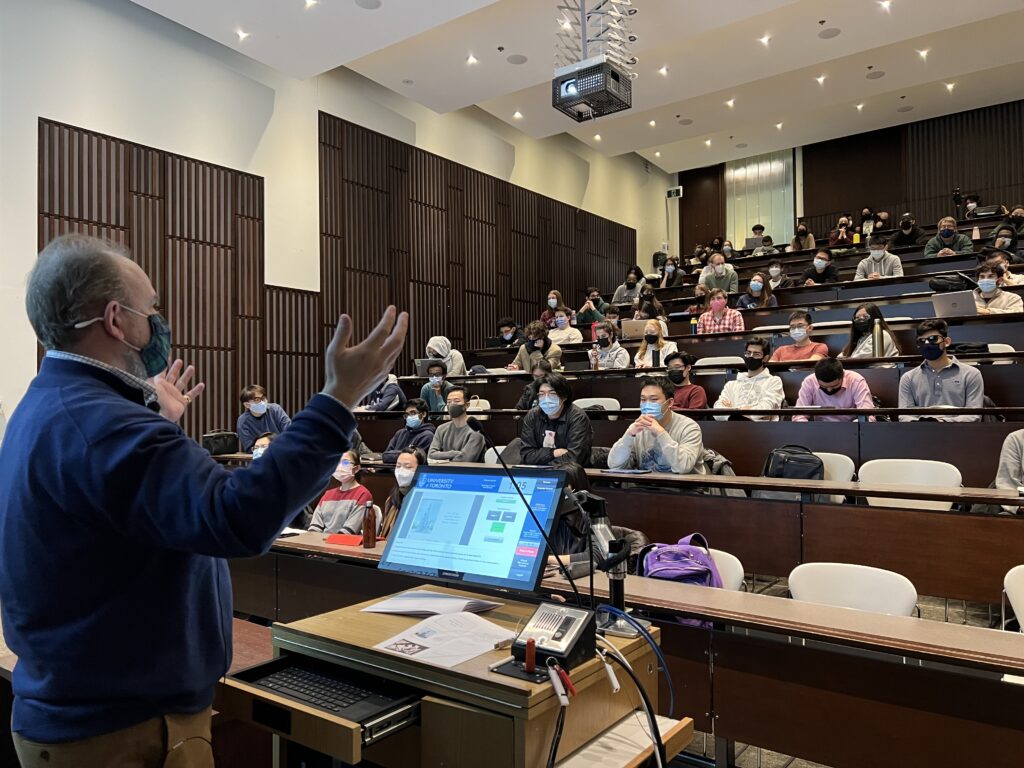The current war in Ukraine served as a backdrop for students listening to a guest speaker on the complexities of rebuilding infrastructure after conflict. The lesson: what you think you know as an engineer doesn’t always apply.

Opening with, “In war, every frame of reference you had changes,” Dr. Alexander (Alec) Hay (CivE PhD 1T9) immediately sets the tone while introducing his talk, Post-conflict rehabilitation of municipal services. In essence, the student engineers are told they might not know everything they think they know about rebuilding infrastructure; “It’s time to reframe their rigid ways of thinking.”
The guest speaker in CIV340 – Municipal Engineering, a class held by Prof. David Meyer, on Tuesday, March 29 is not only a CivMin alumnus, Adjunct Professor and founder of Southern Harbour Ltd, but has extensive field experience. As a former Royal Engineer Officer in the British Army, a post with NATO and other high-profile consulting roles, Hay has such a diverse background in building infrastructure around the world, including areas of conflict, his full list of accomplishments is best left to a glance at his LinkedIn profile.

Hay presents the class, as well as others from U of T Engineering, with examples of how natural and man-made destruction can appear similar. An earthquake in Haiti can have much the same appearance in damage as shelled-out buildings in Aleppo, Syria. The solutions to the similar-looking problems are, however, very different.
“It’s particularly engineers, who think they know the solution, but have a lack of understanding of the situation,” remarks Hay. “You need to have the professional humility to allow yourself to learn.”
The reminder is made constantly. As Hay says, “The great myth of antebellum, build it like it was before the conflict, ignores how conflict has changed the region and its peoples.” The needs of the various peoples across the various areas of a country, can be quite different and need to be assessed before beginning. “We have a balancing act. We need to ensure we protect the most vulnerable; we cannot leave them behind. We are balancing aid with reconstruction.”
Further, besides researching the needs of the people and attempting to fulfill the immediate need(s), confidence needs to be restored. The demand for something like municipal water supply might be severely reduced as the population has moved and/or has lost confidence in the infrastructure. Sometimes encouragement is required to renew the confidence and recapture the demand.

Hay provides further guidance, explaining how the planners and engineers have to work in conjunction with many others to accomplish the overall goals. Often, multiple aid agencies are working together in various areas to provide everything from medical aid and shelter to security and more. “It’s not just engineers there working alone, but with others who all take guidance from local expertise and leadership.” Hay guides the thinking of working with locals as, “Having the humility to talk to others as equals,” adding, “It goes a long way.”
An area in conflict, or in danger of renewed conflict, can experience disruptions unlike those in areas of peace. The weakest link can eliminate essential services to vast areas in an instant. Shelling of a power plant supplying power to a large area can disrupt multiple services, for instance. Or thieves might routinely decide to drop power lines in the middle of the night, taking the raw metals for resale, preventing the continuous operation of a water filtration plant, as was an example Hay supplied from an experience in Iraq. He further explained, “They were removing power supply almost at the same rate we could replace it.”
“I try to black box it – gather the data and focus on what ‘I’m trying to achieve and why”,” responds Hay when asked how he can respond to such varied circumstances and responsibilities. At the same time, he remarks, “You can’t impose aid; you can’t impose reconstruction.”
Turning to current events, the audience receives a query from Hay with, “How will you approach utilities rehabilitation in Kharkiv, Ukraine?” The open question begets, in turn, questions about ongoing fighting. In response, Hay lays out various scenarios of logistics required, as long as there’s no fighting “on the patch of ground you want to work on.”
If the front line is away from the area, one can resume work beginning with data collection, planning, re-opening aid convoy routes, etc. “It’s all a balancing act of what can be sustained, and one that must be constantly re-evaluated.”
The question of why any engineer would choose to work in an area of conflict with possibly low remuneration and high risk, especially where their work could be soon destroyed, Hay is quick and insightful in his response, “Maybe because they have a moral compass?!”
By Phill Snel